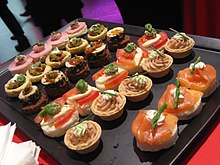Appetizers
Appetizers (including appetizer , appetite bites and from English appetizers , Savouries and starter ) are small appetizers , which are served before the meal to the appetite to awaken. The French technical term is amuse gueule or amuse bouche .
Nibbles (so-called finger food ) without the following menu serve as an independent snack at standing receptions. In contrast to the amuse gueule, they are not served directly at the table, but are continuously offered to guests from platters for consumption.
Production and consumption
In the catering industry in Europe there is the professional profile of the hors d' oeuvrier (also hors d'oeuvire ), who is responsible for starters (French hors d'oeuvre ) and cold cuisine. He is represented by the Gardemanger if there is no hors d'oeuvrier . The job of the Kaltmamsell is to make sauces and dishes from the “cold kitchen”, including appetizers. Examples of appetizers are slices of baguette with sandwiches , small, hearty filled or sandwiched baked goods or pieces of vegetables .
At receptions or a banquet , appetizers are occasionally offered to bridge the waiting time until the start of the menu . They are finger food and are therefore eaten without cutlery even on formal occasions . Some appetizers are meat skewers in miniature format, such as satay or brochettes, or toothpicks are provided as an aid for consumption.
If the appetizers are not followed by a menu, such as at a cocktail party or an aperitif , they represent an independent snack.
Appetizers in different countries
In some countries in Asia , the Caribbean or Southern Europe , appetizers are eaten in bars and pubs with alcoholic beverages . One example of this is the Geera Pork meat dish in Trinidad and Tobago .
In addition, specific terms exist for appetizers in different cultural areas:
- Mezze in Arabic cuisine
- in France hors d'oeuvres , amuse-gueules and amuse-bouches
- in Greece Mezedes
- in Italy tartine or stuzzichini
- in Russia Sakuska
- in Switzerland canapés or "sandwiches"
- in Spain tapas
- in Trinidad and Tobago Cutters
Terminology
The distinction between appetizers as "starters" and as "snacks" is not clear. For example, different mezze are part of traditional Arabic and Greek menus, but they are also offered separately in restaurants or as street food . In addition, it is common in gastronomy to serve a selection of different antipasti as a starter for an Italian menu .
Literature and Sources
- Benoît Molin: Refined things in a spoon (Les meilleures cuillères). Cologne , 2010. ISBN 978-3-8025-3722-6 .
- Ceres cookbook editorial team: Canapés & appetizers - sandwiches, canapés, savory items . Mönchengladbach , 1995. ISBN 978-3-930882-87-8 .
- Anja Halveland: Dr. Oetker: Cold plates . Munich , 2005. ISBN 978-3-8094-1809-2 .
- Markus Plein: Amuse-Gueule - The explosion of ultimate pleasure . Melsungen , 2009. ISBN 978-3-7888-1260-7 .
- Walter Siebert / Gottfried Stoppel: Spoon food in Swabian . Reutlingen , 2012. ISBN 978-3-88627-978-4 .
Web links
Individual evidence
- ↑ Udo Pini: The Gourmet Handbook. Section “Appetizer” (page 40). 4th edition. Tandem publishing group, 2004. ISBN 3-8331-1097-X .
- ^ A b Metz, Reinhold: Restaurant & Guest . 11th edition. Fachbuchverlag Pfanneberg, Haan-Gruiten 2010, ISBN 978-3-8057-0650-6 , p. 407, 409 .
- ↑ NEGI, JAGMOHAN: PROFESSIONAL HOTEL MANAGEMENT . SHREE Publishers & DISTRI, 2014, ISBN 81-219-1518-X , pp. 427 ( google.de [accessed December 1, 2019]).
- ↑ Qualification structure and employment in the hospitality industry. Federal Institute for Vocational Education and Training (BIBB), 2014, accessed on December 1, 2019 .
- ↑ Everything about the kitchen posts in the classic brigade. In: Effilee . September 28, 2005, accessed on December 1, 2019 (German).
- ^ Salma Hage: The Mezze Cookbook - Sharing Plates from the Middle East . Berlin, 2018. ISBN 978-0-7148-7685-6 .
- ↑ Evelyn Boos: Italian Menus - 27,000 creative moments of pleasure combined by yourself . Munich, 2012. ISBN 978-3-8174-8849-0 .


